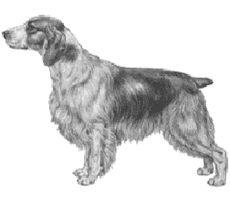Welsh Springer Spaniel
General Information - Welsh Springer Spaniel

Group:
Gundog
Size:
Medium
Lifespan:
12-15 years
Exercise:
Medium
Grooming:
Medium
Trainability:
Medium
Watchdog Ability:
High
Protection Ability:
Low
Area of Origin:
Wales
Date of Origin:
1600s
Other
Names:
None
Original
Function:
Bird flushing and
retrieving
History
The Welsh Springer Spaniel dates to the 1600s in Wales. The 'Springer' Spaniel is so named because of their hunting style which is to spring hidden game. In Wales they are often referred to as starters. It can hunt tirelessly for hours over difficult terrain and is resistant to poor weather as well as being unafraid to jump into very cold water. In Wales it is still frequently used as herder and drover.
Temperament
Happy willing and independent, Welsh Springer Spaniels are outdoor dogs and love to run, hunt, swim and chase. The Welsh Springer Spaniel is equipped for both hot and cold weather. Welsh Springer Spaniels make excellent family dogs and get along well with children.
Upkeep
The Welsh needs daily exercise, which can be met with long walks on leash combined with strenuous games in the yard. It especially likes jaunts a field and makes a good hiking companion. It can live outdoors in temperate climates if given warm shelter, but it does better living inside with its family. The coat needs brushing once or twice weekly and also needs occasional scissoring to neaten stragglers.
Welsh Springer Spaniel
A breed standard is the guideline which describes the ideal characteristics, temperament, and appearance of a breed and ensures that the breed is fit for function with soundness essential. Breeders and judges should at all times be careful to avoid obvious conditions and exaggerations, as well as being mindful of features which could be detrimental in any way to the health, welfare or soundness of this breed.
Breed Standard - Welsh Springer Spaniel
 General Appearance:
General Appearance: Symmetrical, compact, not leggy, obviously built for endurance and hard work. Quick and active mover, displaying plenty of push and drive.
Characteristics: Very ancient and distinct breed of pure origin. Strong, merry and very active.
Temperament: Kindly disposition, not showing aggression or nervousness.
Head and Skull: Skull of proportionate length, slightly domed, clearly defined stop, well chiselled below eyes. Muzzle of medium length, straight, fairly square. Nostrils well developed, flesh coloured to dark.
Eyes: Hazel or dark, medium size, not prominent, or sunken, or showing haw.
Ears: Set moderately low and hanging close to cheeks. Comparatively small and gradually narrowing towards tip and shaped somewhat like a vine leaf.
Mouth: Jaws strong with a perfect, regular and complete scissor bite, i.e. upper teeth closely overlapping lower teeth and set square to the jaws.
Neck: Long, muscular, clean in throat, neatly set into sloping shoulders.
Forequarters: Forelegs of medium length, straight, well boned.
Body: Not long. Strong and muscular. Deep brisket, well sprung ribs. Length of body should be proportionate to length of leg. Loin muscular and slightly arched. Well coupled.
Hindquarters: Strong and muscular, wide and fully developed with deep second thighs. Hindlegs well boned, hocks well let down, stifles moderately angled, neither turning in nor out.
Feet: Round, with thick pads. Firm and cat:like, not large or spreading.
Tail: Customarily docked. Well set on and low, never carried above level of back; lightly feathered and lively in action.
Gait/movement: Smooth, powerful, ground covering action; driving from rear.
Coat: Straight or flat, silky texture, dense, never wiry or wavy. Curly coat highly undesirable. Forelegs and hindlegs above hocks moderately feathered, ears and tail lightly feathered.
Colour: Rich red and white only.
Size: Approximate height:
Dogs: 48 cms (19 ins) at withers; bitches 46 cms (18 ins) at withers.
Faults: Any departure from the foregoing points should be considered a fault and the seriousness with which the fault should be regarded should be in exact proportion to its degree and its effect upon the health and welfare of the dog.
Note: Male animals should have two apparently normal testicles fully descended into the scrotum.
DNZ No 364
Copyright Dogs New Zealand
06 Jan 2013
Any departure from the foregoing points should be considered a fault and the seriousness with which the fault should be regarded should be in exact proportion to its degree and its effect upon the health and welfare of the dog and on the dog’s ability to perform its traditional work.




